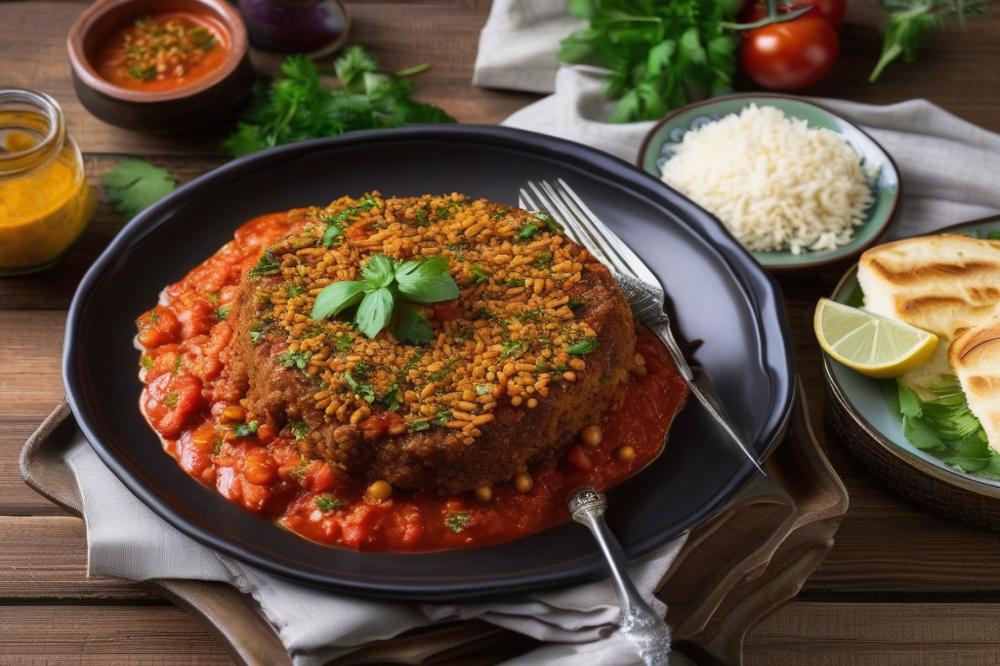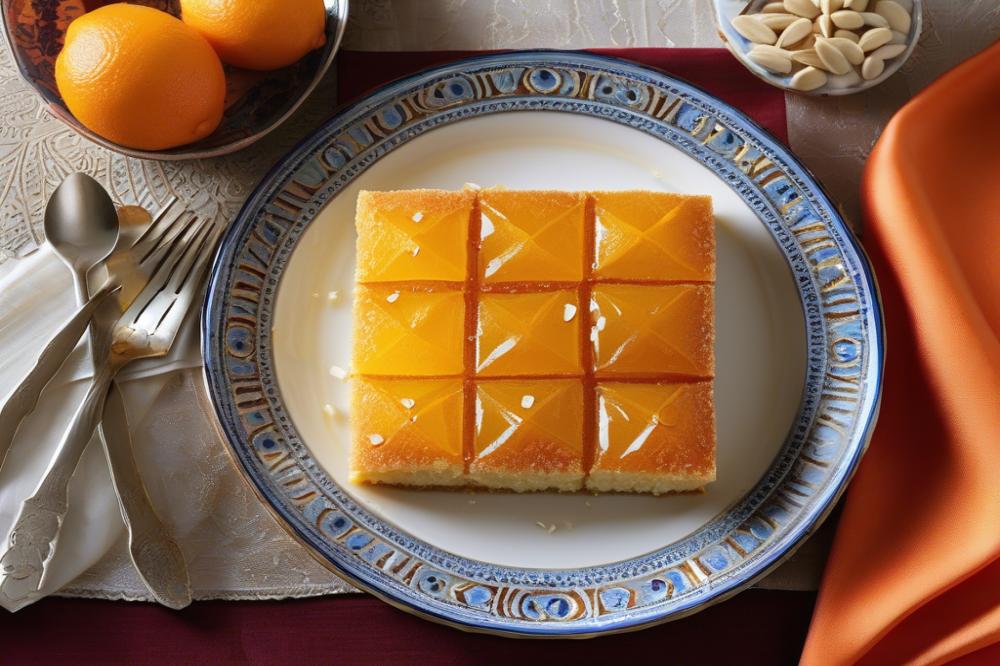Introduction
Moroccan cuisine is a vibrant tapestry of flavors, aromas, and textures. This unique culinary tradition has roots that stretch deep into history, blending Berber, Arabic, and Mediterranean influences. Traditional Moroccan dishes often celebrate the use of fresh herbs and bold spices. These ingredients come together to create a delightful balance between sweet and savory. Every meal tells a story, reflecting the culture and values of the Moroccan people.
Among the many beloved dishes in this cuisine, the Lamb Tagine stands out as a true gem. This slow-cooked masterpiece is a hearty meal meant to nourish both the body and soul. The marriage of tender lamb, fragrant spices, and dried fruits makes it an unforgettable experience. Families often gather around the tagine pot, savoring the layers of flavors that develop over hours of cooking.
Tagine cooking itself is an art form. The conical-shaped clay pot helps trap steam, allowing ingredients to meld beautifully. Those who embrace traditional Moroccan methods appreciate the importance of patience. Slow-cooking allows the flavors to deepen, transforming simple ingredients into an extraordinary dish. Often served with couscous, this recipe is a staple in homes across Morocco, promising comfort and satisfaction in every bite.
Authentic Recipes highlight the centuries-old techniques that have been passed down through generations. In Morocco, food is more than sustenance; it’s a way to connect with family and friends. The preparation becomes a cherished ritual, creating bonds over shared meals. Each dish represents a commitment to preserving rich heritage and culinary art.
Moroccan Lamb Tagine

Moroccan Lamb Tagine is a savory dish that represents the heart of traditional Moroccan cuisine. It is much more than just a meal; it embodies rich flavors and a deep cultural heritage. This dish is commonly enjoyed in homes throughout Morocco and has become a beloved favorite in many households around the world.
The preparation of lamb in a tagine is slow-cooked, which allows the meat to become tender and juicy. As it simmers, flavors blend beautifully. The process takes time, but it’s worth every minute. Ingredients slowly meld together, creating a rich sauce that is full of depth and character.
Another aspect of this dish is its use of aromatic spices. These spices elevate the flavor profile, making each bite a unique experience. Typical spices include cumin, coriander, and cinnamon. They work together to create a warm and inviting taste. Additionally, dried fruits like apricots or dates add a touch of sweetness, balancing the dish perfectly.
Merging these elements makes Moroccan Lamb Tagine a hearty meal that pairs exceptionally well with couscous. This combination is a staple in many Mediterranean cuisine dining experiences. When served, the dish looks vibrant and inviting, often accompanied by a side of fresh bread or a salad.
Tagine cooking is an art form. The special pot, also named tagine, allows for even heat distribution, enhancing the cooking process. Steaming occurs within the pot, maintaining moisture and tenderizing the meat. Home-cooked versions of the dish can vary greatly, reflecting personal touches and regional influences.
Ingredients List and Cooking Instructions

List of Ingredients with Specific Quantities
- Lamb, cubed (1 kg)
- Olive oil (2 tbsp)
- Onion, chopped (1 large)
- Garlic, minced (3 cloves)
- Ground cumin (1 tsp)
- Ground coriander (1 tsp)
- Ground cinnamon (1 tsp)
- Paprika (1 tsp)
- Salt (to taste)
- Black pepper (1/2 tsp)
- Dried apricots, chopped (150 g)
- Almonds, toasted (50 g)
- Vegetable broth (500 ml)
- Fresh cilantro, chopped (for garnish)
- Couscous (for serving)
Detailed Cooking Instructions
Preparation Steps
The first step is searing the lamb. Heat olive oil in a tagine or heavy pot over medium heat. Place the cubed lamb in the pot, ensuring each piece browns nicely on all sides. This step adds depth to the flavor.
Next, sauté the chopped onion and minced garlic. Cook until the onion turns translucent and fragrant. This usually takes about 5 to 7 minutes. The aroma of these ingredients will enhance the dish significantly.
Spices are crucial for a hearty meal. Add ground cumin, ground coriander, ground cinnamon, and paprika to the pot. Stir well to coat the meat and vegetables evenly with the spices. Allow the mixture to cook for a few minutes, so the spices release their oils.
Now it’s time to incorporate the dried fruits. Mix in chopped dried apricots and pour in the vegetable broth. This liquid will help create a savory sauce that brings all the components together. Bring the mixture to a gentle boil.
The slow-cooking method is essential for developing rich flavors. Reduce the heat to low and cover the pot. Let it simmer for about 1.5 to 2 hours. Check occasionally to ensure nothing sticks to the bottom. You want the lamb to be tender and easily shredded with a fork.
For the final touches, taste the tagine and adjust the salt and black pepper if necessary. Once ready, serve the dish over fluffy couscous. A sprinkle of chopped fresh cilantro on top adds a nice color and brightness. Enjoy this traditional Moroccan delight with family or friends, sharing the vibrant flavors of Mediterranean cuisine.
Nutritional Information

Overview of the Health Benefits of Key Ingredients
Moroccan lamb tagine brings together an array of healthy ingredients. Lamb is rich in protein, which is essential for muscle growth and repair. This meat also supplies vital nutrients like iron and zinc, contributing to overall well-being. Vegetables in the dish, such as carrots and zucchini, add fiber and vitamins. These nutrients support digestion and immune function. Dried fruits, such as apricots and raisins, introduce natural sweetness and beneficial antioxidants.
Caloric Breakdown and Nutrients
A hearty meal like this typically ranges from 400 to 600 calories per serving. The lamb contributes a significant portion of the calories, primarily from protein and a bit of fat. Vegetables provide fewer calories but are packed with nutrients. For example, a half-cup of cooked carrots adds around 25 calories and important vitamins like beta-carotene. Dried fruits, while higher in natural sugars, offer fibers that aid digestion. Each ingredient plays a role in ensuring a balanced dish that satisfies both hunger and nutrient needs.
Importance of Balanced Portions
Balanced portions are key when enjoying home-cooked Moroccan meals. Serving tagine with couscous complements the dish nicely. Couscous offers a wholesome source of carbohydrates, which are necessary for energy. It is important to moderate the amount of fat in the meal. Combining it with a side salad can introduce more vegetables and reduce calorie density. Tagine cooking allows flavors to meld, creating a savory experience that is both satisfying and nutritious.
Variations of Moroccan Lamb Tagine
When exploring Moroccan cuisine, there are many ways to enjoy a delicious lamb tagine. Alternative ingredients can offer a new twist to this traditional dish. Some cooks might choose to replace lamb with beef or chicken. Others prefer to use seafood, making for a unique take on tagine cooking. Each option can bring a different flavor and texture that delights the palate.
Vegetarian Options
Vegetarian tagine can be just as satisfying as the meat version. Fresh vegetables like eggplant, zucchini, and bell peppers provide a hearty meal. Legumes such as chickpeas and lentils add protein and richness. Along with spices like cumin, coriander, and saffron, these ingredients create a savory blend. For a sweet contrast, dried fruits like apricots or raisins can be included. This adds depth, making the dish irresistibly flavorful while adhering to a plant-based lifestyle.
Regional Spices and Flavors
Moroccan cuisine varies by region, and each area has its signature spices. In the north, you’ll find a preference for lighter seasonings, using olive oil and herbs. Meanwhile, the south may focus on harsher spices, such as chilies and smoked paprika. This variation adds complexity to any tagine. Incorporating different ingredients allows for a rich tapestry of flavors. Pair your tagine with fluffy couscous, which absorbs the aromatic sauce beautifully, enhancing the taste of each bite.
Every family has its rendition of tagine cooking, reflecting personal tastes and local preferences. Some might add nuts for crunch, while others emphasize herbs for freshness. Embracing these regional influences can turn a simple dish into something memorable. Savory spices combined with sweet ingredients make for harmonious contrasts that transport you straight to Morocco. Each variation tells a story through flavor and tradition.
Cultural Significance of Tagine Cooking
Tagine cooking embodies a rich tradition within Moroccan culture. This method of slow-cooked meal preparation has deep historical roots. Originating from Berber tribes, the tagine pot is designed for cooking over an open flame. Its conical lid traps steam and enhances flavors. Over the centuries, these vessels have become symbols of family and hospitality.
Family gatherings often revolve around the tagine. During special occasions, friends and relatives come together to enjoy a hearty meal. Meals typically consist of lamb, vegetables, and dried fruits, all simmered to perfection. Sitting around a shared dish fosters bonds between people. In these moments, the act of eating becomes more than just nourishment; it transforms into a celebration of togetherness.
Sharing a meal holds significant meaning in Moroccan society. Food serves as a bridge that connects generations, bringing stories and traditions to life. Couscous accompanies many tagine dishes, adding to the communal experience. As plates are passed around, laughter and conversation flow easily, creating a warm atmosphere. Savory dishes, seasoned with a wide range of spices, please the senses and invite everyone to partake.
This culinary practice highlights the importance of Mediterranean cuisine in daily life. Home-cooked meals signify love and care, reflecting each cook’s unique style. The slow-cooking process allows flavors to meld beautifully, resulting in unforgettable tastes. Each recipe tells a story, passed down through time. Truly, tagine cooking plays a pivotal role in celebrating both food and family.
Final Thoughts on Enjoying Authentic Moroccan Cuisine
The allure of Moroccan Lamb Tagine lies in its rich flavors and heartwarming aromas. Every bite transports you to the bustling markets of Marrakech, where spices dance in the air and culinary traditions thrive. This dish showcases the harmony between tender lamb and vibrant ingredients. The slow-cooked method helps meld these flavors beautifully, creating a comforting meal that warms both the body and soul.
Exploring traditional Moroccan cooking is an adventure that many home cooks can embark upon. Trying out the recipe not only introduces you to new flavor profiles but also invites you to embrace a culture deeply rooted in hospitality and community. Don’t hesitate to get creative with ingredients. Substitute or add vegetables and fruits based on personal preferences. Experimentation can lead to delicious surprises.
Pairing this savory dish with couscous or warm bread enhances the experience. These side options allow you to soak up every bit of the rich sauce. Enjoying it with family or friends elevates the meal even further. Moments shared over home-cooked meals create treasured memories.
Ultimately, a Moroccan Lamb Tagine is more than just food. It represents a journey into a vibrant culture that emphasizes flavor and togetherness. So, roll up your sleeves, gather your ingredients, and let the spices guide you. This homemade delight is sure to bring joy and warmth to your dining table.



